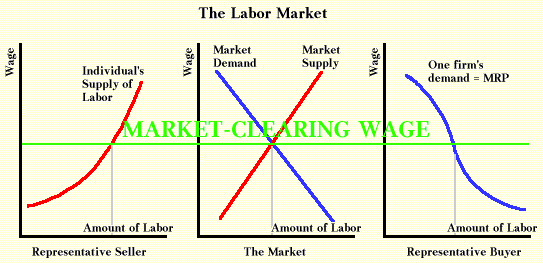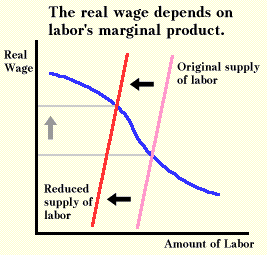Marginal Productivity and Income
The basic theory for resource markets is part of the theory of the firm. Key concepts are those of marginal resource cost (MRC) and marginal revenue product (MRP). A firm maximizes profit when it sets MRC equal to MRP. Let us briefly review this result.
Common sense says that a firm will tend to buy a resource if the added benefit to the firm (the MRP) exceeds the added cost (MRC). The added benefit is the value to the firm of the extra output that the resource produces. If increasing the amount of the resource raises revenues more than it raises costs, a firm can increase its profits by using more of the resource. This is the case of MRP exceeding MRC, so we have shown that the firm can increase profits when MRP is greater than MRC. If reducing the amount of a resource cuts costs by more than it cuts revenues, a firm can increase its profits by using less of the resource. This is the case of MRC exceeding MRP, so we have shown that the firm can increase profits when MRP is less than MRC. It follows that if the firm has maximized profits, MRP must equal MRC. If the firm should increase resource use when MRP exceeds MRC, and if it should decrease resource use when MRP is less than MRC, then it is using just the right amount when MRP equals MRC. Three-fourths of the difficulty in understanding this result comes from the terminology--if you have problems understanding this result, reason it out with no economic terminology and then translate the reasoning into terminology.
The amount of the resource that a firm wants to buy depends in part on the extra revenue it can get from selling production that the resource adds. A resource is valuable not because it directly satisfies some goal, but because it can indirectly satisfy a goal. Economists say that the demand for a resource is a derived demand. The demand for the resource is derived, or comes from, the demand for the goods and services that the resource produces.
To push the analysis further, assume that many firms buy the resource and that none of these firms can noticeably influence price in any market. This assumption that firms are price takers means that marginal revenue equals price of output, and that the marginal resource cost equals the price of the resource. To make the following discussion less abstract, suppose that the resource in question is hours of labor, which means that the price in this market will be wages.
With these assumptions, we get a diagram similar to that used to explain the technicalities of economic efficiency. On the left is Peter Milloy, a representative worker who sells hours of unskilled labor. His supply curve is drawn so that it slopes upward. But he is only one of a great many workers selling in this market. To find the market supply curve, one must add up all the hours of work that will be offered at each wage.

On the right is Dynamic Enterprises, one of a great many buyers of unskilled labor. Its demand curve will be the downward-sloping part of its MRP curve. The MRP curve is the demand curve for labor because this curve tells how valuable another unit of the resource is to the firm. Hence, given a wage, one can tell how much labor a firm demands by looking at the MRP curve.
Dynamic Enterprises is only one of a great many buyers of labor. To find the market demand, one must add up at each wage the number of labor hours demanded by each firm. The intersection of the market demand and market supply curve gives the equilibrium wage--it will hire all workers who contribute more to the firm than they cost.
There are some important results that come from this simple analysis. First, owners of resources are paid their marginal contribution to output. An owner of a resource that adds a more valuable contribution to output is paid more than an owner of resource that adds a less valuable contribution. The key words here are "marginal" and "adds." For example, garbage collectors perform a vital service in large cities, and when they go on strike, people are not only tremendously inconvenienced, but their health may be threatened. The total value of the services of garbage collectors is very high. But this high total value does not mean that the value of another garbage collector is high. If adding or removing one garbage collector changes the value of garbage collection services little, his marginal contribution will give a low wage in this market. This analysis exactly parallels the diamond-water paradox.
The graphs above can help illustrate changes that will raise or lower wages or other payments to inputs. There are two reasons why the demand curve could shift. First, it could shift because people value the output more. For example, the high salaries of professional basketball players are due to the popularity of basketball as a spectator sport. A century ago, a man with the same abilities of a Larry Bird or a Michael Jordan would have earned a normal income because there was no demand for his special talents.
Second, the demand curve could shift because of increased productivity, perhaps caused by changes in the amounts of other resources. A trend in industrialized societies has been to replace physical work with machines. As a result, the rewards going to muscle power have fallen as compared to the rewards going to brain power. Two hundred years, ago a strong but stupid man would probably have earned more than his smart but lame brother. Today, the results would probably be reversed.
The supply curve can also change, and as it does, so will the income that the resource earns. A new discovery of metal ore will reduce the value of known deposits. Increased availability of education increases the numbers of doctors, lawyers, teachers, and accountants. If demand for their services does not change, their increased numbers will cause their incomes to drop. People who want to control the wages they earn have usually tried to control the supply curve.
Adding together all buyers and sellers of unskilled labor or aggregating them, is useful because it gives us insights. Sometimes, extreme aggregation is useful, such as treating all labor services in the same market. This sort of extreme aggregation is basic to macroeconomics. In the case of labor markets, such aggregation is useful if we slightly alter the graph above
Equilibrium in the labor market requires that MRC=MRP. With the assumption that everyone is a price taker, this condition can be written as
(1) Marginal Product x Price = Wage.
If we divide both sides by price, we get
(2) Marginal Product = Wage/Price = Real Wage.
The real wage, or wages divided by prices, measures the purchasing power of what workers earn. If, for example, wages increase by 10% and so do prices, then the amount that workers can buy has not changed.
The illustration below graphs the marginal product of labor and the supply of labor as a function of the real wage. Suppose that the amount of labor declines. The supply curve will shift to the left, the marginal worker will become more productive, and the real wage will rise. Labor will become more scarce relative to land and equipment, which have not changed. The Black Death in 14th-century Europe reduced population by about 30% in a few years. As the illustration suggests, real wages rose as a result.

The graph also suggests why economists in the 19th century so often saw population control as a way to solve poverty. Fewer people will, other things held equal, increase wages and more people will reduce them. However, those other factors have often not remained equal in the real world. Europe is densely populated and Africa is sparsely populated, yet Europe has a vastly higher standard of living than Africa.
Next we look at something called tournament theory, which tells us we can error by only focusing on marginal productivity.
Copyright Robert Schenk